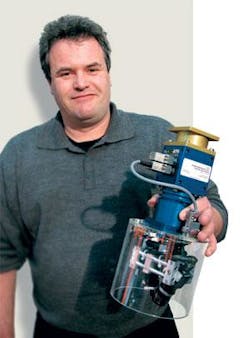Camera inspects drill holes
“After engine blocks are cast,” says Stefan Schwager, president of Sidonia Systems (Stockdorf, Germany; www.sidoniasystems.com), “a head gasket is placed on the engine block and the cylinder head bolted to it. Before this can occur, however, each of the bolt threads on the engine block must be carefully inspected to ensure that no cavities or imperfections in the screw thread exist.
“To ensure this is performed correctly, the screw thread must be visualized from a number of different angles to ensure that no cavities exist in the sidewalls of the screw. Because of this, the inspection task has been relegated to human operators who can rapidly visualize the integrity of the screw walls,” says Schwager. To mimic the task of human inspectors, Sidonia Systems has developed a novel camera that uses off-the-shelf machine vision components and custom software.
Known as the LS700 cavity detector, the camera system consists of a single XCHR70 VGA camera from Sony (Park Ridge, NJ, USA; www.sony.com) and a red laser LED spotlight illuminator from CCS America (Waltham, MA, USA; www.ccsamerica.com) mounted on a motorized gantry. To image the inner thread of the numerous bolt threads that comprise an engine block, the LS700 is first mounted on an x, y, z gantry that is placed over the engine block. In this way, the camera can be moved across the engine block and properly positioned at each bolt thread and then moved vertical to obtain the optimum field of view for the camera (see photo, below).
After the camera is properly positioned, both the camera and illumination system are rotated within the detector’s housing. “By rotating the camera every 36º, ten different images of the inside screw thread can be captured,” says Schwager. These images are digitized by a PC2 frame grabber from Dalsa (Waterloo, ON, Canada; www.dalsa.com) and transferred to PC host memory.
To identify the many different faults that may have occurred to the threads during the manufacturing process, however, was not a simple task. “If a cavity exists at the very bottom of a screw thread,” says Schwager, “then the fault is less severe than if the same fault occurred at the top of the thread.” Thus, both the size of any holes or imperfections must be measured and these data linked to the position of each hole in the thread.
Sidonia Systems LS700 cavity detector, a motorized camera and illumination system, can be used to image the inside of automotive screw threads.
While Manto software, part of the Common Vision Blox library from Stemmer Imaging (Puchheim, Germany; www.stemmer-imaging.de), could be used to identify the size and position of these holes, expert reasoning needed to be applied to classify each defect. To do this, Sidonia Systems added database software written in Delphi PASCAL to the system to allow operators at ZF Friedrichshafen (Friedrichshafen, Germany; www.zf.com) to individually classify defective images. As multiple images of the bolt screw threads were taken by the system, they were then classified by human experts and stored in the image database. Comparing these images with images taken from production line engine block threads allows the system to properly classify the images.
“Typically,” says Schwager, “an engine block will have as many as 20 independent screw holes that need to be inspected. With the LS700 system, this task can be accomplished in approximately two minutes. At a cost of approximately €150,000, the system is as yet still in prototype stage at ZF Friedrichshafen, one of the world’s largest suppliers of automatic transmissions, synchronized transaxles and engine blocks for cars, trucks, and construction machinery, with worldwide sales in excess of €11 billion. However, the company plans to develop a standard version of the system that can be used on many of its production lines.


